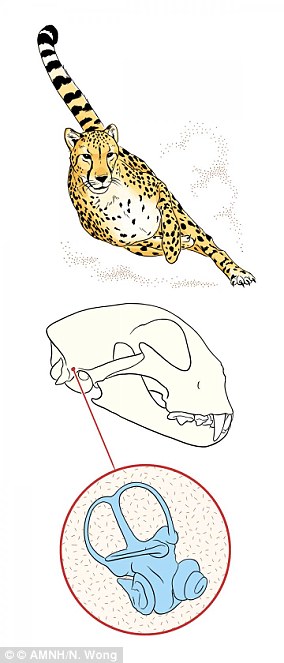Cats and dogs are notorious for not getting on with each other.
While one has a loud bark, the other has sharp claws – often leading to hilarious stand–offs between the animals.
But this adorable pair are exceptions to the rule.
An Australian zoo has recruited a puppy to help socialise a cheetah cub after she had to be separated from her mother.
A video shows the pair playing happily together, in scenes reminiscent of the hit film Homeward Bound.
The 1993 American adventure film features a trio of two dogs – Chance and Shadow – and a cat – Sassy – who get lost.
While they initially don’t have a strong bond, the trio develop a close relationship throughout their journey.
Now, new footage shows a young cheetah cub, Rozi, and Ziggy the labrador–kelpie–collie mix, showing that close bonds and friendship truly can transcend species.

An Australian zoo has recruited a puppy to help socialise a cheetah cub after she had to be separated from her mother

Rozi’s name means rose, a symbol of joy in Swahili. Keepers decided to find her a friend to avoid the threat of living in isolation for 18 months
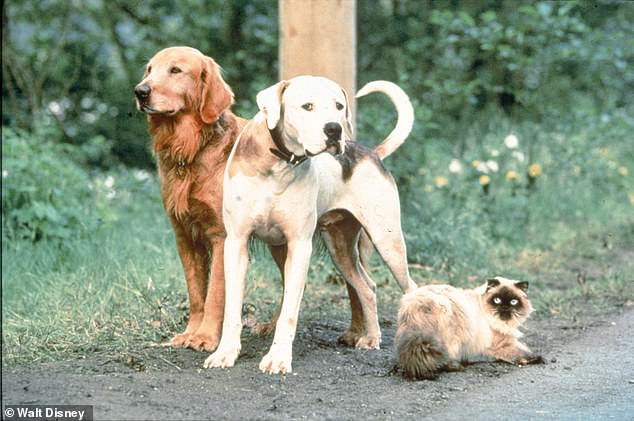
The friendship between (big) cat and dog is reminiscent of that portrayed in the hit film Homeward Bound (pictured)
Rozi was born in February at the Taronga Western Plains Zoo in Dubbo, Australia, by emergency C–section after her mother Siri went into labour early.
Sadly, the two had to be separated as Siri never produced milk and Rozi was critically unwell for the first weeks of her life.
Rozi’s two siblings were stillborn, and so to prevent her being lonely and facing the prospect of 18 months in isolation, keepers decided to find her a step–sibling.
She was introduced to Ziggy when they were both around two months old under the careful handling and supervision of zoo staff.
But it wasn’t long until the pair were playing freely and snoozing together.
‘They match each other so well with their energy level, the type of play that they do and their size,’ Jordan Michelmore, a zookeeper at Western Plains Zoo, told New Scientist.
‘The dopeyness, the lightheartedness and the looseness of a puppy seem to match Rozi pretty well for this stage of life.’
In a video, shared online by the zoo, she added: ‘The pair of them have now become best friends, and it’s beautiful to watch their relationship develop.
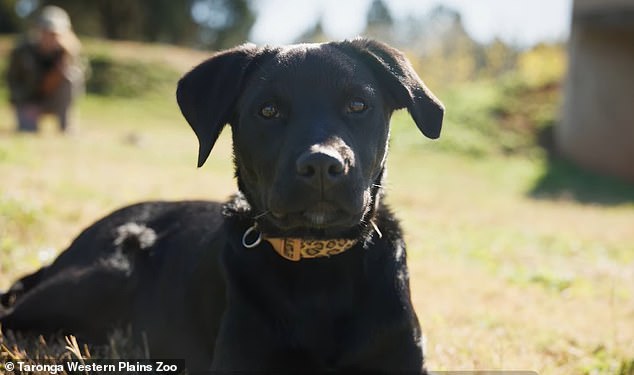
Keepers decided that Ziggy would be the perfect step–sibling for Rozi, as both of her siblings were stillborn
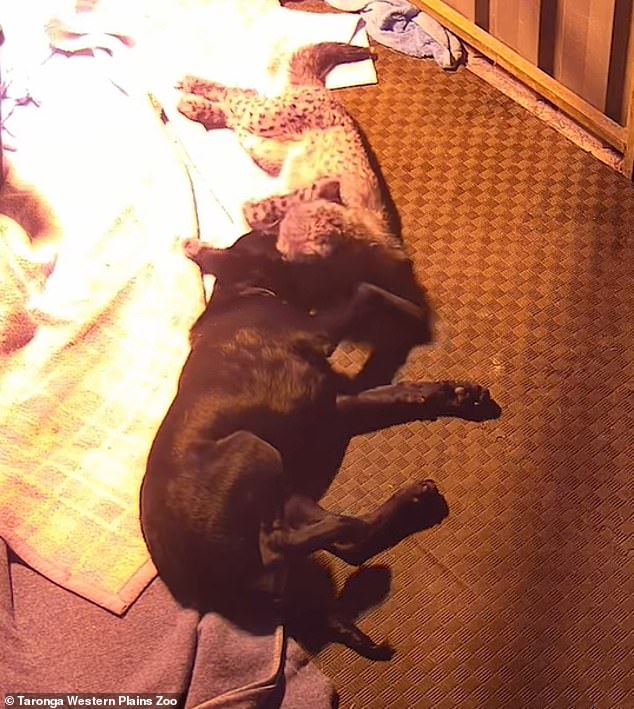
The pair even snuggle up at night to sleep together – showing the strong bond of friendship and trust they have formed
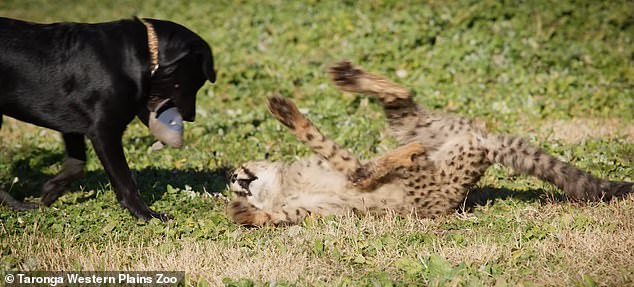
Playful footage shows the young cub, Rozi, and Ziggy the labrador–kelpie–collie mix showing that close bonds and friendship truly can transcend species
‘They’ll chase each other, she’ll stalk Ziggy and pounce on him and he’ll chase her.’
She revealed this is not the first time the zoo has introduced a cheetah cub to man’s best friend.
Siri, Rozi’s mother, was also a single cub, and became incredibly close with a puppy she was introduced as a youngster. ‘Now it does truly feel full circle,’ Ms Michelmore said.
Ziggy, who keepers describe as an ‘annoying big brother’, is ‘truly a wonderful dog’ who has the ‘perfect nature’ for the job.
His role at the zoo will last ‘around a year’ – roughly the same amount of time that cheetah cubs spend with their siblings.
This is the time when female cheetah cubs usually become solitary, the keepers said. At this point, Ziggy will be adopted.
‘Our goal is for Rozi to join our cheetah breeding program,’ Ms Michelmore added. ‘So by having these kinds of relationships now with the puppy, it builds her confidence and social skills.
‘In the future, when hopefully she’ll get introduced to a male cheetah for breeding, hopefully she’ll have that confidence and that socialisation.’
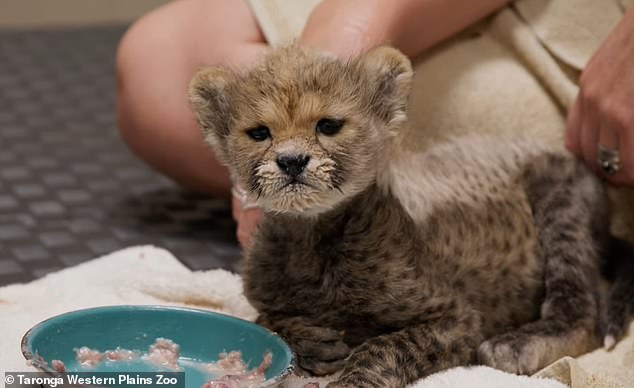
Rozi was critically unwell for the first weeks of her life, and her mother did not produce any milk
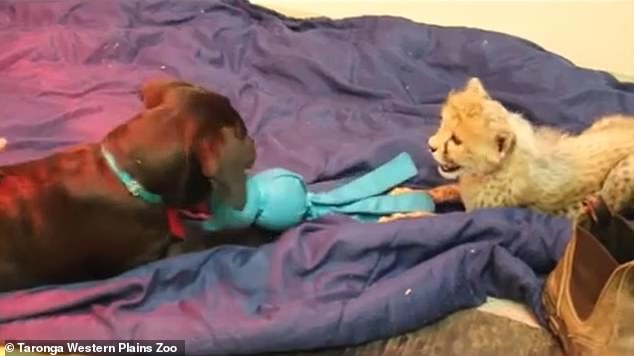
Archive footage shows Rozi’s mother Siri playing with a puppy when she was a cub. Keepers said the new friendship represents a ‘full circle’ moment
In an online post, the zoo said: ‘Both cub and puppy are living behind the scenes at the Zoo’s Cheetah breeding facility, and it’s hoped that Rozi will one day play a part in the regional breeding program for her vulnerable species.
Rozi’s name means rose, a symbol of joy in Swahili, and there’s no doubt both her and Ziggy are bringing joy to all of us here at Taronga Western Plains Zoo.’
Cheetahs are classified as vulnerable in the wild with fewer than 7,000 mature individuals remaining.
Wild populations continue to decline due to human–wildlife conflict, loss of habitat and habitat fragmentation, poaching and illegal wildlife trafficking.
Cheetahs are also notoriously difficult to breed, so every birth is extremely valuable to the global population.
Taronga Western Plains Zoo is part of the international Cheetah breeding program, and the first Australasian zoo to breed the species.

